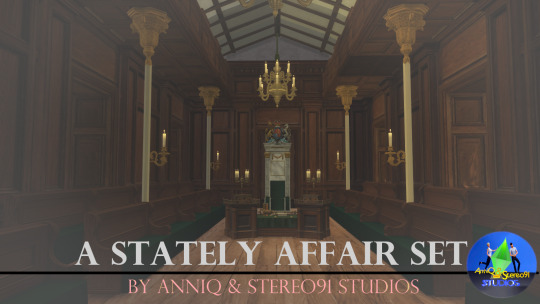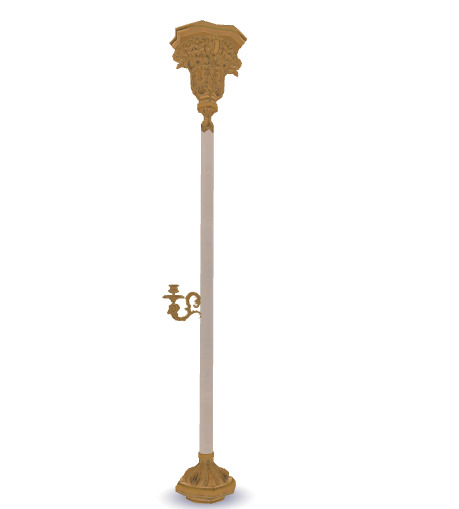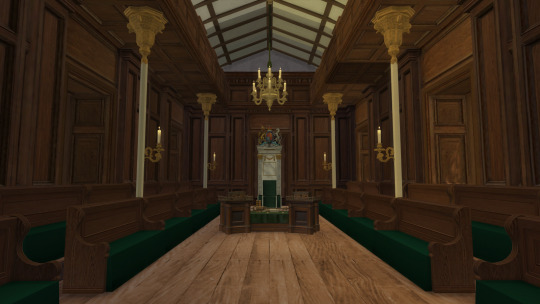#parliamentary panels
Explore tagged Tumblr posts
Text
Parliamentary Panel Summons SEBI Chief and Officials Amid Allegations of Conflict of Interest
Parliamentary Panel Summons SEBI Chief and Officials Amid Allegations of Conflict of Interest The Public Accounts Committee (PAC) of the Indian Parliament has issued a summons to the chairperson of the Securities and Exchange Board of India (SEBI), Madhabi Puri Buch, and top officials from other key government departments. The officials, including representatives from the Department of Economic…
#Adani Group#Conflict of Interest#Hindenburg Research#Indian Parliament#Madhabi Puri Buch#Parliamentary Panel Summons SEBI#Public Accounts Committee (PAC)#Regulatory Oversight#SEBI
0 notes
Text
NOW AVAILABLE ON PATREON.


This set was inspired by the British House of Commons as it was during the 17th, 18th and 19th centuries before it was reduced to ashes in the fire of Westminster Palace in 1834.






This set contains 22 matching items with multiple swatches.
This set includes...
1 Speaker's Chair/Throne
2 Parliamentary Benches
1 Functional Debating Station (Needs Discover University Pack to work)
1 Very Large Fireplace
2 Friezes
2 Tall Wall Panels
1 Small panel
2 Window Panels
1 Railing
1 Banister
1 Banister/Railing Post
1 Triangular Panel For Stairs
1 Wall Column
1 Column With Candlestick Holder
2 Fake Balconies
1 Over Door Head Panel
1 Large Door
Each item is an original mesh. All items are in the base game except for the debating station ...

The debating station requires Sims 4: Discover University Expansion Pack.





We really hope you enjoy this little set. We have aimed to give the textures a touch of realism in their appearance. All of the pictures you see above have not been edited, and look exactly as they do in the game.
We STRONGLY recommend using the BB.Moveobjects cheat in order to make the placing of each item easier.
We hope you enjoy!!!
As usual, if you have any questions or problems feel free to message me.
EARLY ACCESS - UNTIL 12/10/2024
LINK:
#sims4#sims 4 cc#sims 4#thesims4#the sims 4#sims4cc#historical sims#sims 4 historical#sims 4 creations#historicalsims#sims 4 history challenge#sims 4 royal simblr#sims 4 royalty
173 notes
·
View notes
Text




Maximilien Robespierre was executed on July 28, 1794, or the 10th of Thermidor in the Republican Calendar. A conventional textbook may mark the end of the French Revolution with Napoleon’s coup in 1799. But Ralph Korngold, Marxist historian, wrote:
“No one man creates a revolution or carries it on, but the currents of revolution may sometimes range themselves in such a manner that the fate of one man becomes the fate of the revolution itself. ‘We did not realize,’ said Cambon, ‘that in killing Robespierre we would kill the Republic.” (From Robespierre and the Fourth Estate–the “fourth estate” here referring to the budding proletarian class of the time. Korngold gave particular attention to Robespierre’s role in the attempt to enact the Ventôse Decrees, the most revolutionary laws proposed during the Republic which would have expropriated the wealth of counter-revolutionaries to be redistributed to the propertyless.)
Napoleon’s ascent ten years after the start of the Revolution only marked the final stab in a Republic that was already good as dead. The death of Robespierre and his allies was the death of the Revolution’s radical aspirations, and allowed the propertied men to fully take charge. Though I also appreciate the sentiment that we can also mark the Revolution’s end a bit after Robespierre, with the death of Babeuf, the “proto-communist."
Anyway, what I really wanted to do was talk about a phenomenal short film that came out this year (on Robespierre’s birthday), “La mort de Robespierre” by smileyfaceorg/Janelle Feng (who has done so much amazing art about Robespierre and the French Revolution).
The film focuses on the night before 10 Thermidor, before Robespierre’s forceful arrest. This historical episode has been depicted before, in various ways. In the 1989 movie La Revolution Francaise, Robespierre had gone insane at this point, an interpretation that fed off of years of black propaganda. In Feng’s film, Robespierre is depressed, remorseful and self-loathing, an interpretation that does have its footing in historical record. In the months leading up to his arrest, Robespierre was frequently sick from the mental exhaustion of running and defending the Republic.
Mental health isn’t a new thing, though we have admittedly only recently begun to be articulate on the subject. Mental health amongst revolutionaries isn’t new either. Even Lenin died of sickness likely compounded by the stress of protecting the Revolution’s gains. In the 1871 Paris Commune, the commune council was “a working, not a parliamentary body [but] executive and legislative at the same time,” which allowed members to fully dedicate themselves to the cause of building a socialist future, but also burdened them with a punishing workload with little room for rest, and the mental exhaustion that naturally follows. I’m sure every person in any radical movement knows the weight of the struggle, but that’s one reason why it must be a collective effort.
At one point in the film Saint-Just looks at the 1793 Declaration of Rights on the wall and comments “To think we made that.” It’s another historically-rooted moment, as there was at least one eyewitness account claiming he did something like that on that night. I think the presence of the 1793 Declaration also ties the film in with the radical tradition of interpreting the Revolution. The ‘93 Declaration was more egalitarian than the initial 1789 Declaration, signed off by a pressured Louis XVI and also the one more textbooks would remember.
I love the use of comic elements too. Comic devices in film would make me think of stuff like Spiderverse or Scott Pilgrim where it’s fun and wacky, but in this film Feng uses comic devices to contract and expand space and time to an introspective yet claustrophobic effect. Especially the scenes where panels surrounded by negative space hint at Robespierre’s inner turmoil. It works really well; comic elements can work like poetry, after all.
I love stuff like this, art that is rooted in history (with quite scholarly rigor) while also aiming to go beyond academic scholarship. You can’t quite explore things like emotions and human experience the same way you can through art. Art like this film looks at historical facts and tries to fill in the gaps. How did they feel about this, what kind of effect did it have? And it explores how these historical people and episodes were human. More importantly, it does so with empathy and purpose, keeping in the “spirit” of the historical figures depicted. If you truly read Robespierre, you wouldn’t give in to lazy portrayals of a mad dictator. In contrast, Feng’s short film shows so much care and attention for this person in the past.
I’m so happy that someone like Feng is making art about the French Revolution. Most of the films, novels, games, etc that come out about the French Rev usually just follow the boring, very liberal and mainstream narratives, and calumnies about Robespierre being a dictator or various other kinds of monsters (not true). Korngold wrote about this too: “The Red Terror appears unpardonable to the Whites, and the White Terror to the Reds. Carlyle penetrates closely to the truth when he says that the reason the Reign of Terror during the French Revolution has received so much scathing comment, is mainly because it was directed against the privileged classes and their followers and not against ‘the voiceless millions.’”
Like the rest of history, our interpretation of the French Revolution exposes the undercurrents of ideology, conscious or not. Our ideas of who should be in power, who should be listened to. Ultimately, it did end as a revolution of the budding bourgeoisie, but before that defeat, there were revolutionaries who imagined and fought for a new future for all. Not just a political revolution, but a social and economic one. We should remember their revolutionary example. There is a reason, after all, why the Soviets held the likes of Robespierre, Saint-Just and Marat in high regard.
57 notes
·
View notes
Text
Brazil's Supreme Court unanimously accepts the indictment, and five men become defendants in Marielle Franco's case
Brazão brothers, Rivaldo Barbosa, Robson Calixto Fonseca, and Ronald Paulo de Alves will face criminal action

On Tuesday (18), the First Panel of Brazil’s Supreme Court (STF, in Portuguese) accepted the indictment filed by the Attorney General's Office (PGR, in Portuguese) against the alleged masterminds of the murder of Rio de Janeiro councilwoman Marielle Franco and driver Anderson Gomes, and the attempted murder of parliamentary aide Fernanda Chaves, which happened in March 2018.
All five justices who make up the collegiate voted to accept the charges. Flávio Dino, Cristiano Zanin, Luiz Fux and Carmen Lúcia fully followed the rapporteur's vote, Justice Alexandre de Moraes.
In this phase, the panel analyzes whether the charge meets the legal requirements and whether there is evidence of the crime and its authorship. The trial is being held by the Supreme Court, due to the privileged jurisdiction of Chiquinho Brazão, who is a federal deputy from Rio de Janeiro.
The judiciary accepted the charges, making brothers Chiquinho and Domingos Brazão, the former head of the Civil Police of Rio de Janeiro Rivaldo Barbosa, as well as Military Police major Ronald Paulo Alves de Paula, and Robson Calixto Fonseca, a former advisor to Domingos Brazão, defendants who will face criminal prosecution for the crimes.
Continue reading.
#brazil#brazilian politics#politics#marielle franco#domingos brazao#chiquinho brazao#rivaldo barbosa#robson calixto fonseca#ronaldo paulo alves de paula#image description in alt#mod nise da silveira
8 notes
·
View notes
Text
ON THIS DAY - 14 October 1586
On This Day (14 Oct) in 1586, the trial of Mary, Queen of Scots began at Fotheringhay Castle, Northamptonshire: she had been charged with plotting the assassination of Elizabeth I.

Mary had been arrested on 11 Aug 1586 whilst being held prisoner at Chartley Manor, Staffordshire; she had been held there since Dec 1585, the residence of Robert Devereux, 2nd Earl of Essex. From here she was transported to nearby Tixall House, before finally being moved to Fotheringhay on 25 Sep 1586.

It was whilst at Chartley that Mary corresponded with Anthony Babington, a Catholic and long-time supporter of hers; letters were written in cypher and transported in and out of the house in beer barrels. Babington was the head of the eponymous 'Babington Plot' - a conspiracy to assassinate Elizabeth and place the Catholic Mary on the English throne. However, Elizabeth's Secretary of State and 'spymaster' Sir Francis Walsingham was able to intercept these letters, leading the arrest of Babington, his co-conspirators and eventually Mary. It was these letters that were used as evidence against Mary, and led to her being tried on charges of high treason.

Mary's trial was held in the Great Hall at Fotheringhay - an 'examination' of the evidence by a panel of English nobles, under the 'Act of Association'. Being found guilty under this act would lead to Mary being stripped of her claim to the English throne, and lawfully being put to death. She appeared in person at 9 o'clock in the morning, in front of crown representatives and noblemen, including William Cecil, Baron Burghley (Elizabeth's Lord High Treasurer) Walsingham and George Talbot, 6th Earl of Shrewsbury, under whose custody she had been held for 15 years. She wore her favoured garments of her captive years: a black velvet dress and mantle, with white headdress (with widows peak) and veil.

Mary denied the charges put to her, as well as arguing that she had been denied access to legal counsel. She continued to assert her authority as an anointed queen, and expected to be treated so. Correspondence between the two were passed around, in addition to Babington's deposition and signed confessions of two co-conspirators; Mary denied ever having met Anthony Babington, and accused Walsingham of inventing the cyphers and manufacturing the plot to implicate her. However, she confirmed that she continued to support Catholic interests in England, as well as abroad.

Elizabeth had ordered that no sentence be passed until all the evidence had been presented to herself, and following the conclusion of the trial on 15 Oct, the panel returned to London. Their findings were subsequently presented to Elizabeth on 25 Oct 1586 at the Star Chamber in London; Mary was found guilty of being "not only accessory and privy to the conspiracy, but also an imaginer and compass of her majesty's destruction" and a sentence of death was passed. However, Elizabeth continued to demonstrate ambiguity, requesting attempts to obtain a 'full confession' from the Scottish Queen, in an attempt to save her life, and void any retaliatory action from Mary's Catholic allies abroad.

#tudor#tudors#tudor women#tudor queens#tudor england#tudor history#history#England history#tudor people#Elizabeth i#Mary queen of scots#francis walsingham#Anthony babington#Babington plot#George talbot#bess of hardwick#Charley manor#Framlingham castle
2 notes
·
View notes
Note
Sorry if this is an incredibly stupid ask but how do you learn about the symposiums/lectures/panels you sometimes mention in asks? I've been looking to get more involved in my community but have no idea how to find lectures series or other programs.
It's not a stupid question at all, anon! It can be really hard to know where to start, especially as so many women's organisations and outlets can look like one thing (progressive, informative and supportive!) and end up being another (conservative, TERF-y and divisive).
The symposium I was at yesterday was a bit of an outlier. One of my current projects I am writing on is a documentary about how patriarchal government structures that are in theory there to help families navigate separation and single motherhood actually enable the continuation of family violence through financial abuse. It's pretty specifically looking at Family Court, the Australian Tax Office, the Australian Child Support Agency and Centrelink (our welfare system), and how these systems force single mothers into poverty that usually becomes generational poverty.
The director and I had interviewed someone who's involved in a paper that's being tabled in parliament next month specifically about the failures of the Child Support Agency, and she invited me to come to this because she was (along with a number of other women) presenting on her findings. That was closed to the public because it did have government representatives there and the paper itself isn't published yet.
Honestly, the best way to start getting into this sort of thing is to stay up-to-date with your local news. If you're in Australia (hell, even if you're not), Women's Agenda is an excellent place to start as, while it's imperfect, it's independent, owned entirely by women, and really tries to focus on both local and international news that's concerned with the rights of women, and I do think it works hard to be intersectional. Once you start reading regularly, you'll pick up the names of journalists that you like or that you feel are talking about areas of concern that you feel deeply about, and following those journalists on social media will usually lead you to podcasts, books, documentaries and events that they're either promoting or involved in, which will usually then lead you to other women doing other things that you can follow and get involved in yourself.
It can also be good to look at local ideas festivals or centres like writer's festivals which will sometimes be platforming feminist writers. Libraries are often doing these sorts of things, particularly larger libraries, and book stores (book launches can be great platforms for conversation about new non-fiction books concerned with areas of feminist thinking and quote-unquote 'women's issues'), and just googling around (or even looking at Eventbrite) to see if you have centres like the Victorian Women's Trust and The Wheeler Centre or even university focus clinics (one of the presenters yesterday runs one on tax and domestic violence which we talked a lot about) in your area which are invested in discussion and debate around these sorts of conversations.
But yes, the news I think is really the biggest thing. I've been invested in feminist issues and circles for about a decade, but I've usually worked in safety, so I'm pretty new to economic justice as a space of interest, so it's been a real education. That was motivated partially by what my sister's going through, but a lot of the events I've been to were triggered by the April news that a parliamentary inquiry was about to happen about the role of banks in preventing financial abuse. When these inquiries happen, there are often a bunch of adjacent lectures and events that happen to amplify conversations, so knowing that often will lead you to them.
#i hope this is a help!#there are community groups too if you're looking for more hands on things too#but a lot of the time you'll find those through these sorts of things too#i've cooled off since last night#phew#i had a pretzel and watched a movie it did wonders for my mood haha
5 notes
·
View notes
Text
Proponents of the US supporting Israel through massive military aid packages often tout the fact that Israel is a democracy. They never delve much into Israeli politics, however. I would love for supporters of Israel to study more about Israeli politics because I arrived at my views critical of Israel largely by looking at their political system, particularly researching the Knesset and which parties hold the power and looking at how they function.
Most Westerners think "democracy" and picture countries like the US and Western European countries like the UK, France, Germany, Spain, Sweden, or Italy. Israel has a parliamentary system more like most European countries and less like the US.
But unlike any of the Western democracies countries I listed above as examples, Israel's government has been dominated by right-wing politics over almost their entire existence. Netanyahu has been described to me as a Trump-like figure, combining xenophobic and racist tendencies, consolidation of power in the executive portion of the government, with vaguely right-leaning domestic policies. He was first elected prime minister in 1996 and has held the office for a total of 16 years, and when not in that position, he has been in the government in other key roles. Even before Netanyahu, the right, embracing hardline views on things like settlements, land grabs, treatment of Palestinians, and censorship of the Nakba, has dominated Israeli politics.
The left has little power in Israeli politics. Israel's largest center-left party, Yesh Atid, currently only holds 24/120 seats in the Knesset. This party corresponds roughly to the mainstream policies of the Democratic party in the US. It is not particularly progressive, just left-leaning and often described as centrist. It still tolerates a lot of the atrocities committed by Israel. It is the largest part of the opposition to the current government, but this opposition includes a loose alliance with other, mostly less-progressive factions. The next-largest alliance in the opposition is National Unity (8 seats) which consists largely of centrist-to-independent military (IDF) interests, and the third-largest is Yisrael Beiteinu (6), a conservative party that historically represented mostly Russian-speaking secular Jews, the United Arab List (5) which is a conservative Islamist party, and New Hope, which is another right-wing party. The only progressive parties in the opposition are the Hadash–Ta'al joint list, and labor, and between all these parties the progressives control only 9/120 seats, which exactly 7.5% of the seats.
So left-leaning parties in Israel have only 33/120, or 27.5% of the seats. And only 7.5% of them are progressive. Only the progressives and the conservative Islamist party are critical of Israel's treatment of the Palestinians.
Imagine what the US would be like if someone like Trump had been president for 16 years, and for another 12 years had been in the Senate. And if the Democrats controlled only 27.5% of the seats in congress, and much of the opposition to Trump were just from anti-Trump conservatives.
That's what Israel is like now.
Yeah, it's a Democracy. It's a Democracy where an overwhelming majority of the citizens keep voting for a genocidal, power-hungry government and have been doing so for decades. It's a Democracy where the left is left with scraps, where even centrists or moderates are marginalized and the only power is held by the far-right.
It's not free the way countires in Western Europe or even the US are. We take for granted the type of freedom of protest. In Israel, Hasidim get beaten by police when the protest the government. Jewish Israeli Journalists get doxxed and their families threatened, when they publish material deemed too critical of the government. Members of the legislature get shut down when they speak out too strongly about what is going on. Right-wingers and hardliners are able to openly voice calls to violence and other extremist stances, but people on the left get suspended when they draw analogies between what Israel is doing and what Nazis did during the holocaust, like how Ofer Cassif was suspended for 45 days:
Please be mindful of this when you defend Israel as a "democracy", or see others doing so. Yes, it is a democracy. But what does this mean? A democracy allows people to vote to take away people's rights. A democracy allows people to vote to tolerate or condone genocide.
And remember, it is only a democracy for citizens; people who had lived on the land for generations and were forced out by violence, and who either refuse to follow the processes of the state that forced them out in order to become citizens, or cannot follow those processes, are not given the right to vote. This is why people say it is an apartheid state. Israeli citizens can vote; Palestinians cannot.
2 notes
·
View notes
Text
Newspaper Helsingin Sanomat covered a propaganda exhibition seen near the Finnish Embassy in Moscow.
The street exhibition dubbed "The Stages of Finnish Russophobia" by the Russian Military Historical Society, appeared opposite the Finnish Embassy in Moscow on Thursday, consisting of six billboard-style panels with text and images. However, a separate, larger exhibition with 16 panels also appeared roughly a kilometre away on Gogolevsky Boulevard.
The society's exhibition aims to show how Finland, having joined Nato and "turned its back on Russia", has actually been "anti-Russian" throughout history.
HS wrote that in Russia, it is still often difficult to understand, at least for ordinary citizens why Finland, which was widely considered neutral by the Russians, suddenly joined Nato and broke off decades of relations with Moscow.
The historical society said it located the exhibit opposite the Finnish Embassy because it is the sole remaining Finnish mission in Russia.
The street display attempts to illustrate Finland's history of Russophobia.
For example, pointing to the time in history when Finland was under Russian rule, the exhibit characterises the Nordic country as ungrateful.
Another panel highlights Finland's aspirations of a Greater Finland in the 1920s and 1930s, showing a map of Finnish nationalists' ambitions to annex land across wide swaths of Russian territory.
Other aspects of the propaganda exhibit detailed Finland's military actions in World War II against the Soviet Union and Finnish tourists drinking cheaply "at the expense of the Soviet Union" in the 1970s and 1980s. The exhibit ends with a panel showing Nato's new borders with Russia, along with military bases and tales of Finns fighting in Ukraine.
While most people walking past the exhibit did not want to speak to the Finnish newspaper reporter, one person said that the exhibit was a simple lashing out at Finland and Sweden because they joined Nato.
However, another passerby said: "Finland is part of Russia. Finns cannot live apart from Russia".
A circle of stars on a field of blue
Ahead of the upcoming EU Parliamentary elections, rural-focused newspaper Maaseudun Tulevaisuus, asked why the European Union flag is rarely seen.
When the flag is visible in Finland, it is often at press conferences or ports of entry, while it is seen more often in other EU countries.
Janne Juujärvi, an interior ministry senior specialist, pointed out that the use of the flag differs.
"Finland has a very strong culture of flagging with the Finnish flag, and the European flag is used, for example, alongside the Finnish one at border crossing points on the EU's external borders and at international airports and ports," explained Juujärvi.
"As a rule, the Finnish flag is only flown on official flag days. Then again, there are countries in Europe where, for example, flags are flown all the time outside office buildings," Juujärvi said.
MT explained there is also a logistical factor behind the issue — there's a lack of flagpoles.
If people in the Nordic country were to fly the EU flag as often as they hoist Finnish ones, they would need a second flag pole — which is not common in Finland.
Midsummer forecasts
Tabloid Iltalehti reported that Midsummer in Finland could be warm this year, according to the monthly forecast of the European Centre for Medium-Range Weather Forecasts.
As Midsummer is still three weeks away, the forecast is still unclear, but it looks like it'll be warmer than average across Finland over the long holiday weekend.
According to the Finnish Meteorological Institute (FMI) long-term forecast, the average high temperature for Midsummer will be around 20 degrees Celsius in the south and 14-16 degrees in the north. In the south, nighttime temperatures are forecast to be around 10 degrees and 4-6 degrees in the north.
After a few weeks of little precipitation, rainfall is expected to be above average in the weeks leading up to Midsummer, according to the paper.
4 notes
·
View notes
Text
So it has been asked that I put this in it's own post rather than a thread, so I am:
...
Over the last several years, many "rad fem" leaders and organizations have come to ally with LGB &T hate groups and the Christian right because they, "know who real women are." It is these christian right groups like the FRC and ADF who are behind many of the anti-abortion, anti-women movements through the U.S. and Europe. They're also behind a lot of anti-trans policies and legislation.
You can read a bit about who is behind funding these policy initiatives, and how much money goes into these campaigns below:
European Parliamentary Forum
Southern Poverty Law Center on the ADF
Southern Poverty Law Center on the FRC
And you can read about the connection between these groups and trans-exclusionaries and radical feminists below:
Southern Poverty Law Center on the Far-Right Anti-Trans Laws
Southern Poverty Law Center on the Anti LGBT Campaigns
Political Research Associates on Partners with the Christian Right
An "Unlikely" Ally
The Women's Liberation Front (WoLF), for example, accepted a $15,000 grant from the religious freedom giant, the Alliance Defending Freedom. They also co-authored an anti-trans parenting guide with the Family Policy Alliance, and then partnered with them again to release a homophobic press releases decrying how LGB labels "sexualize" children because no child thinks about sexual orientation (so couldn't possibly know they're gay for any other number of reasons). They've also held conferences and panels with Christian-right organizing groups, namely, the Heritage Foundation.
We've also seen countless radical feminists appear on Tucker Carlson Tonight and the Ingraham Angle, two Fox hosts well-known for whipping up anti-immigrant, xenophobic sentiment in America's Christian Nationalist movement. Speakers included: Meg Kilgannon, Kara Dansky, Tammy Bruce (and here), and Julia Beck.
The term "gender ideology" even has its origins in alt-right Christian circles. And don't even get me started on the use of "hygiene" to describe cis people and the fact they co-opted the idea that certain people-in this case, trans people- have "contaminating" genes from literal eugenics movements. TERF complaints about the supposed existence of "cancel culture" and "woke culture" even echo conservative and right-wing rhetoric.
But it gets worse.
White supremacists and white supremacist organizations (See: Richard Spencer’s Radix for primary example) are trying to turn TERFs into “race realists.” And they're actually having a lot of success because 1.) the movement is chronically white, 2.) the movement is built a lot on social fears, and 3.) the movement often uses crime statistics as a recruitment and justification point (these statistics are used to convince white feminists that there are specific demographics of men they need to be "protected" from). Literal white supremacists are using the TERF's social grievances and crime statistics to "enlighten" these supposed feminists about what they call the "race question." Over-policing and capitalistic deprivation of resources have devastated black and brown communities, making members of those communities the disproportionate victims of incarceration. Simply pointing out crime and incarceration stats without nuance, which TERFs like to do with their "trans women are all sexual predators" crime argument, has actually helped the bottom line of white supremacists.
They're using the standard TERF's belief in the divine feminine-- the idea that natal women have a unique biology which should be protected and venerated-- to convince them that there are "masculine" and "feminine" energies and turn them onto the trad life. And they're tapping into the TERF's unaddressed "benevolent" sexism-- a type of sexism that positively rewards people assigned female at birth for observing their sex-assigned social prescriptions from presentation to roles to a cis identity, and which holds that women should be protected (by the [masculinist] state) and revered, most especially for their unique biology-- to convince them that "modern society" and "modern feminism" is diseased and the antithesis to their liberty. And it's working. It's working precisely because TERFs are so eager to separate people into "biological" castes so that men are men and women are women (and never the twain shall meet), define women as a discrete biological caste ("the sex that can bear offspring or produce ova"), and reify gendered associations, specifically the association that men are Aggressors and women are passive Recipients of said aggression. This ideology actually does quite a bit to uphold patriarchal ideas that define women as a discrete biological category and it also encourages a system whereby men act on behalf of and choose for women (the Aggressor v. Recipient social prescription does a lot to justify rape culture, or men acting aggressively on behalf of and choose for women).
This is why notorious misogynists like Matt Walsh have shown open support for high-profile TERFs and have taken the "Adult Human Female" slogan and run with it. There's a reason these men on the "right" of the political spectrum can't stand the existence of trans people, but will voice support for TERFs and their ideology and use their language. The TERF ideology is sexist and they're sexists, so it follows.
But the bitch of it is that they know this. They openly admit it, but like to play too dumb to know that their movement is collaborating with the alt-right simply to score a political point against trans people. They all hate trans people existing so much, they've allied with the people who'll cut off their hands and gouge their eyes out.
“I do feel kind of nervous about working with the right wing because they have opposed women’s bodily autonomy…”
-Julia Beck
TERFs have put their eggs in the same basket as people passing anti-abortion policies, people trying to pass girl's genital inspection policies for sports, people trying to ban LGB books, people who want to repeal the right to gay marriage, and people who believe that a woman's "place" is in the home- serving a husband and children all to score a political point against trans people.
That is why I always say that in trying to create a feminism that excludes trans people, TERFs have created the very tool with which the alt-right will use to destroy feminism all together.
You can read more about their connections below:
Posie Parker, TERFs Find Audience with White Supremacists
Anti-Trans 'Feminists' Appear at Panel of Right-Wing Heritage Foundation
Tucker Carlson Looks at FPA Partnership with Radical Feminists
Conservative group hosts anti-transgender panel of feminists 'from the left'
The Unholy Alliance of Trans-Exclusionary Radical Feminists and the Right Wing
The "unlikely" political alliance against trans care
Introduction: TERFs, Gender-Critical Movements, and Postfascist Feminisms
Unpacking “Gender Ideology” and the Global Right’s Antigender Countermovement
Call them what they are. They aren't feminists. They're anti-trans activists. They're the latest iteration of an anti-feminist movement.
#TERFism is yet just another iteration of white feminism#it's the ideological conclusion of girl-boss feminism#and white supremacy#txt#feminism#radical feminism
39 notes
·
View notes
Text
WIP - NOW AVAILABLE - 18th Century English Parliamentary Items
















We have tried to create some items from the 18th-century House of Commons since political fever has recently hit various countries. Since we like creating historical CC we decided to make some items from the old English House of Commons.
We have had to adapt it to fit the rules and boundaries of the game but it all works well.
This mini set is great for historical storytelling and allows you to build a House of Commons themed debating room.
This set includes:
1 Speaker's Chair/Throne
2 Parliamentary Benches
1 Functional Debating Station (Needs Discover University Pack to work)
1 Very Large Fireplace
2 Friezes
2 Tall Wall Panels
1 Small panel
2 Window Panels
1 Railing
1 Banister
1 Banister/Railing Post
1 Triangular Panel For Stairs
1 Wall Column
1 Column With Candlestick Holder
2 Fake Balconies
1 Over Door Head Panel
1 Door
Part 2 may follow in future
We Hope You Enjoy
LINK:
#sims4#sims 4 cc#sims 4#the sims 4#thesims4#sims4cc#historical sims#sims 4 historical#sims 4 creations#historicalsims#sims 4 download#sims 4 royalty#sims 4 history challenge#sims 4 royal simblr#sims 4 legacy#sims 4 story#sims 4 screenshots#sims 4 gameplay#ts4 simblr#ts4
145 notes
·
View notes
Text









On December 13, within the framework of the joint project of LB.ua and EFI Group "Нова країна" [New Country], a discussion panel was held, dedicated to the challenges and prospects that Ukraine will face in 2024.
The guests of honour at the discussion this time were:
Kyrylo Budanov, head of the Main Directorate of Intelligence of the Ministry of Defense of Ukraine; Serhiy Marchenko, Minister of Finance of Ukraine; Serhiy Rakhmanin, member of the parliamentary committee on national security, defense and intelligence; Ihor Liski, chairman of the supervisory board of EFI Group.
Mykhailo Podolyak, Adviser to the Head of the Office of the President, also joined the discussion. The white chair that he sits on is the chair meant for the audience.
3 notes
·
View notes
Text
A parliamentary panel on agriculture had, in a report tabled in parliament on March 23 this year, revealed that the government was far from its 2022 goal of doubling farm income. The panel said the average monthly agricultural household income had risen by a meagre amount of Rs 2,000 from Rs 8,059 in 2015-206 to Rs 10,218 in 2018-2019. Devinder Sharma, an agriculture expert, said farmers were unable to reap the "rightful income". "They are caught in the vicious debt cycle. The government must ensure direct income support to bail them out," he said.
Karam Prakash, '10,881 farm suicides in 2021, most in 5 years; Punjab sees 270 deaths', Tribune
5 notes
·
View notes
Note
are you …german? (alternatively: why are you being interviewed by a cdu guy?)
lmao i am not at all german, i am from new zealand BUT i have been learning german for some years and am applying for a few scholarships in the hopes of moving there for a bit next year!
i have a very scary interview for a parliamentary scholarship (and i absolutely do not meet the fluency requirement) in december, and the chair of the interview panel is an MP from the CDU. looked him up and he voted against equal marriage rights in 2017 so im sure my gay self will make a great impression
are you german/do you speak german? i welcome anyone ever to talk at me auf deutsch - i’ve gotta get much better in the next two month
4 notes
·
View notes
Text
@waywardcollective
It was spitting with rain in the city centre, at one end of the war memorial mile, and an enormous crowd thronged the nexus of wide streets near parliament. A press conference was about to be held in a room upstairs, and a bad performance to the public today would mean slaughter at the ballot box. But Mr Maitland and his team needn’t have worried; the police could barely hold the crowd back from the railings, swaying forwards for handshakes and tokenistic waves, brandishing political hand signals, festooned with colourful rosettes. As Maitland’s car rolled up, eager hands had to be pushed away from it lest they were burned by the front grille in the effort to reach out and touch the little silver figurehead on the bonnet.
First Maitland emerged, lavishing handshakes and well-wishes and Scantex-sponsored leaflets on the crowd, followed by a stout woman in military uniform, and a young man - Maitland’s assistant and political prodigy, a talented, handsome parliamentary draughtsman called Sebastian Reed. These two joined their boss in the fanfare, smiling, waving, looking housewives in the eye with a sparkle of humanity and an expertly deployed compliment; and had nearly made their way through the furore to the open doors at the end of the barrier when suddenly Sebastian’s gloved hand connected with someone’s before he got a chance to look at their face. His smile faltered - only for a moment, only by a millimetre - before it was back in full force. He grasped the hand of the young man firmly, and looked into his eyes with the full force of all the humanity he had learned to mimic in perfect simulacrum over the years. He noticed the young man’s gaze draw towards the cufflinks at his wrist, faintly embossed with a set of initials and a university emblem. In return his own attention flickered to the pass hanging around the man’s neck - press or staff, he couldn’t identify - before he hurried on through the doors with his colleagues.
Upstairs, sitting behind Maitland at the press conference, Sebastian paid little attention to the proceedings. He sought an answer for that man’s presence here, he assessed the dangers he presented, the solutions that could be orchestrated against them. He did not register any surprise or disconcertedness. He did not indulge in little weaknesses such as this. But one thing was certain: he had just seen the face of his creator, living, in the flesh, for the first time since the old man had died five years ago. Once the panel discussion was over, Sebastian headed straight for the company car around the back of the building, briefcase under his arm, cufflinks already removed. He did not get far down the marble colonnade before he heard footsteps echoing sharply behind him.
2 notes
·
View notes
Text
TEL AVIV, Israel—Israeli Prime Minister Benjamin Netanyahu is determined to curb the powers of the Supreme Court. Can the court itself stop him?
Earlier this week, the far-right government led by Netanyahu rammed a bill through parliament that undermines the court’s judicial review powers, escalating the monthslong crisis over its larger plan to overhaul the country’s legal system.
Now, as weekly mass protests on the streets continue, thousands of military reservists refuse to report for duty, and global credit rating agencies register deep concern, the showdown moves to the Supreme Court.
Petitions have already been filed by legal and civil society groups against the bill, an amendment to a quasi-constitutional Basic Law that eliminates the Supreme Court’s ability to strike down government decisions and appointments on the grounds of “extreme unreasonableness.”
“The law to abolish the ‘standard of reasonableness’ threatens to give the executive branch power that is not subject to judicial review, and to allow it to govern without restraints and limitations,” read the petition by the Israeli Bar Association. “It is part of the legal plan announced [by the government in January] … that outlined a road map for dismantling the judicial system as it was built in the 75 years of the state.”
The Supreme Court has said it will take up the petition in September, although legal experts believe that date may be moved up (on appeal) to August, with an expanded panel of nine or 11 justices likely to sit in judgement.
The stakes could not be higher: a court weighing in on the legality of a law limiting its own powers, passed in parliament with a clear albeit slim majority, amid a backdrop of hundreds of thousands of citizens on the streets demanding to save the country’s democracy.
“Each and every one of us has a tremendous obligation to continue to resist and to defend with our souls and bodies the Supreme Court so that it can protect us,” the protest movement’s steering committee wrote to supporters via WhatsApp this week, vowing to escalate what is already the largest and most sustained civic rebellion in Israel’s history.
Such an intervention by the court would be unprecedented. Though justices have struck down regular laws in the past, they have never ruled on the legality of a Basic Law. Israel has a total of 13 Basic Laws, which many legal experts and politicians view as the basis of a proto-constitution—though passing a basic law or an amendment requires only a simple parliamentary majority.
Since the legislation in question is an amendment to a Basic Law, the court would be effectively ruling that the constitutional amendment is unconstitutional, a contortion that law professor Suzie Navot describes as “an unconventional weapon.”
“[The court] has the power to strike down a Basic Law, but it would be the first time. It will be a challenging petition,” said Navot, a vice president at the Israel Democracy Institute, a nonpartisan think tank, hinting at the larger political and social fallout likely at the forefront of justices’ minds.
Presiding over all this is Supreme Court President Esther Hayut, a steely, no-nonsense jurist who earlier this year publicly clashed with the Netanyahu government over its judicial overhaul agenda. Hayut and one other liberal justice are set to step down in October due to mandatory retirement rules at the age of 70, adding further immediacy to the proceedings since the court is then set to tilt more conservative.
Some experts believe that Hayut may, as a legacy move, try to steer the court in the direction of striking down the controversial law, known as the “Reasonableness Bill.”
“Historically, chief justices ahead of retirement are more activist. They may feel they have nothing to lose, and so we’ve seen instances of last-minute courageous rulings,” said Barak Medina, a law professor at Jerusalem’s Hebrew University. “This was in normal times. We’re far away from normal times right now.”
According to several legal experts, Hayut and her colleagues may rely on two relatively unproven precepts of Israeli constitutional law.
The first and more straightforward argument the court may make is on the substance of the law passed this week: that it is simply unconstitutional, despite the fact that Israel has no written constitution.
The court may decide that the law “infringes upon the basic values, the basic principles, of … Israel [as] a Jewish and democratic state,” Navot said.
“If [parliament] enacts a Basic Law that decides that Israel is no longer Jewish … we would have the same discussions that we’re having today. [Parliament] does not have the power, it’s not legitimate, to change the basic structure and values of the state.”
Medina, from Hebrew University, added that the court may view the recent law as undermining Israel’s “core democratic values, like the separation of powers, independence of the courts, and the power of judicial review.”
The second argument the court may deploy would be built not on the substance of the law, but rather on the context within which it was passed and the motivations behind it. In this scenario, according to Medina, the court would strike down the law as “an abuse of the constitutive and legislative power” of parliament, wherein it misused its power for its own individual or political needs.
Legal experts admit the above doctrines are still unclear and untested, although that may change—and soon.
The Supreme Court next week is expected to take up a different petition against another controversial amendment to a Basic Law passed by the Netanyahu government earlier this year. That law makes it harder to declare a prime minister unfit for his position and removed from office.
If the Supreme Court strikes down this law, Medina said, it would “give us a strong indication in which direction Hayut is pulling. It’s a testing ground for the ‘Reasonableness Bill’ petition and could create a precedent for the court.”
The reaction by lawyers representing the government’s position is instructive, arguing in an official written response to the Supreme Court that it does not have the power to strike down a Basic Law.
Netanyahu’s Likud party also deployed the analogy of an “unconventional weapon” in its statement to the media. “If the Supreme Court strikes down a Basic Law, that will be the straw that breaks the camel’s back, and will lead to utter chaos. That is a nuclear weapon that mustn’t be used.”
If the Supreme Court does ultimately strike down the Reasonableness Bill, tensions inside the country between the government and its opponents—already sky-high in the past seven months—would likely surge. Analysts believe the government might choose to not comply with the decision—or to escalate its war against the legal system, moving to legislate the entire removal of all review powers from the courts and government legal advisors. This would likely precipitate a complete constitutional crisis between the branches of government.
“It would bring us closer to an explosion, and a full-on collision,” says Medina, though he added that it may take some time until the government’s noncompliance materializes in practice.
If it does, the chiefs of Israel’s vaunted military, intelligence, and police organs might be forced to take sides—either with the government or the courts. The head of the Mossad foreign intelligence agency, David Barnea, was quoted by Channel 12 News on Monday as telling his subordinates: “If a constitutional crisis unfolds, I’ll be on the right side of history—but we’re not there yet.”
Navot, for her part, hopes that moment never arrives
“If the government does not obey the court, then why should … anybody else?” she said. “I hope we don’t get to that point. But we might.”
Appearing on CNN on Thursday, Netanyahu pointedly refused to say that he would.
“We’ll go into uncharted territory,” he said about the prospect of the Supreme Court striking down the bill. “I really would like to believe they won’t do that. We’re all subject to the rule of law—the prime minister, the parliament, and the judges … everyone is subject to the rule of law.”
3 notes
·
View notes
Text
CHAPTER VII—HACKNEY-COACH STANDS
We maintain that hackney-coaches, properly so called, belong solely to the metropolis. We may be told, that there are hackney-coach stands in Edinburgh; and not to go quite so far for a contradiction to our position, we may be reminded that Liverpool, Manchester, ‘and other large towns’ (as the Parliamentary phrase goes), have their hackney-coach stands. We readily concede to these places the possession of certain vehicles, which may look almost as dirty, and even go almost as slowly, as London hackney-coaches; but that they have the slightest claim to compete with the metropolis, either in point of stands, drivers, or cattle, we indignantly deny.
Take a regular, ponderous, rickety, London hackney-coach of the old school, and let any man have the boldness to assert, if he can, that he ever beheld any object on the face of the earth which at all resembles it, unless, indeed, it were another hackney-coach of the same date. We have recently observed on certain stands, and we say it with deep regret, rather dapper green chariots, and coaches of polished yellow, with four wheels of the same colour as the coach, whereas it is perfectly notorious to every one who has studied the subject, that every wheel ought to be of a different colour, and a different size. These are innovations, and, like other miscalled improvements, awful signs of the restlessness of the public mind, and the little respect paid to our time-honoured institutions. Why should hackney-coaches be clean? Our ancestors found them dirty, and left them so. Why should we, with a feverish wish to ‘keep moving,’ desire to roll along at the rate of six miles an hour, while they were content to rumble over the stones at four? These are solemn considerations. Hackney-coaches are part and parcel of the law of the land; they were settled by the Legislature; plated and numbered by the wisdom of Parliament.
Then why have they been swamped by cabs and omnibuses? Or why should people be allowed to ride quickly for eightpence a mile, after Parliament had come to the solemn decision that they should pay a shilling a mile for riding slowly? We pause for a reply;—and, having no chance of getting one, begin a fresh paragraph.
Our acquaintance with hackney-coach stands is of long standing. We are a walking book of fares, feeling ourselves, half bound, as it were, to be always in the right on contested points. We know all the regular watermen within three miles of Covent-garden by sight, and should be almost tempted to believe that all the hackney-coach horses in that district knew us by sight too, if one-half of them were not blind. We take great interest in hackney-coaches, but we seldom drive, having a knack of turning ourselves over when we attempt to do so. We are as great friends to horses, hackney-coach and otherwise, as the renowned Mr. Martin, of costermonger notoriety, and yet we never ride. We keep no horse, but a clothes-horse; enjoy no saddle so much as a saddle of mutton; and, following our own inclinations, have never followed the hounds. Leaving these fleeter means of getting over the ground, or of depositing oneself upon it, to those who like them, by hackney-coach stands we take our stand.
There is a hackney-coach stand under the very window at which we are writing; there is only one coach on it now, but it is a fair specimen of the class of vehicles to which we have alluded—a great, lumbering, square concern of a dingy yellow colour (like a bilious brunette), with very small glasses, but very large frames; the panels are ornamented with a faded coat of arms, in shape something like a dissected bat, the axletree is red, and the majority of the wheels are green. The box is partially covered by an old great-coat, with a multiplicity of capes, and some extraordinary-looking clothes; and the straw, with which the canvas cushion is stuffed, is sticking up in several places, as if in rivalry of the hay, which is peeping through the chinks in the boot. The horses, with drooping heads, and each with a mane and tail as scanty and straggling as those of a worn-out rocking-horse, are standing patiently on some damp straw, occasionally wincing, and rattling the harness; and now and then, one of them lifts his mouth to the ear of his companion, as if he were saying, in a whisper, that he should like to assassinate the coachman. The coachman himself is in the watering-house; and the waterman, with his hands forced into his pockets as far as they can possibly go, is dancing the ‘double shuffle,’ in front of the pump, to keep his feet warm.
The servant-girl, with the pink ribbons, at No. 5, opposite, suddenly opens the street-door, and four small children forthwith rush out, and scream ‘Coach!’ with all their might and main. The waterman darts from the pump, seizes the horses by their respective bridles, and drags them, and the coach too, round to the house, shouting all the time for the coachman at the very top, or rather very bottom of his voice, for it is a deep bass growl. A response is heard from the tap-room; the coachman, in his wooden-soled shoes, makes the street echo again as he runs across it; and then there is such a struggling, and backing, and grating of the kennel, to get the coach-door opposite the house-door, that the children are in perfect ecstasies of delight. What a commotion! The old lady, who has been stopping there for the last month, is going back to the country. Out comes box after box, and one side of the vehicle is filled with luggage in no time; the children get into everybody’s way, and the youngest, who has upset himself in his attempts to carry an umbrella, is borne off wounded and kicking. The youngsters disappear, and a short pause ensues, during which the old lady is, no doubt, kissing them all round in the back parlour. She appears at last, followed by her married daughter, all the children, and both the servants, who, with the joint assistance of the coachman and waterman, manage to get her safely into the coach. A cloak is handed in, and a little basket, which we could almost swear contains a small black bottle, and a paper of sandwiches. Up go the steps, bang goes the door, ‘Golden-cross, Charing-cross, Tom,’ says the waterman; ‘Good-bye, grandma,’ cry the children, off jingles the coach at the rate of three miles an hour, and the mamma and children retire into the house, with the exception of one little villain, who runs up the street at the top of his speed, pursued by the servant; not ill-pleased to have such an opportunity of displaying her attractions. She brings him back, and, after casting two or three gracious glances across the way, which are either intended for us or the potboy (we are not quite certain which), shuts the door, and the hackney-coach stand is again at a standstill.
We have been frequently amused with the intense delight with which ‘a servant of all work,’ who is sent for a coach, deposits herself inside; and the unspeakable gratification which boys, who have been despatched on a similar errand, appear to derive from mounting the box. But we never recollect to have been more amused with a hackney-coach party, than one we saw early the other morning in Tottenham-court-road. It was a wedding-party, and emerged from one of the inferior streets near Fitzroy-square. There were the bride, with a thin white dress, and a great red face; and the bridesmaid, a little, dumpy, good-humoured young woman, dressed, of course, in the same appropriate costume; and the bridegroom and his chosen friend, in blue coats, yellow waist-coats, white trousers, and Berlin gloves to match. They stopped at the corner of the street, and called a coach with an air of indescribable dignity. The moment they were in, the bridesmaid threw a red shawl, which she had, no doubt, brought on purpose, negligently over the number on the door, evidently to delude pedestrians into the belief that the hackney-coach was a private carriage; and away they went, perfectly satisfied that the imposition was successful, and quite unconscious that there was a great staring number stuck up behind, on a plate as large as a schoolboy’s slate. A shilling a mile!—the ride was worth five, at least, to them.
What an interesting book a hackney-coach might produce, if it could carry as much in its head as it does in its body! The autobiography of a broken-down hackney-coach, would surely be as amusing as the autobiography of a broken-down hackneyed dramatist; and it might tell as much of its travels with the pole, as others have of their expeditions to it. How many stories might be related of the different people it had conveyed on matters of business or profit—pleasure or pain! And how many melancholy tales of the same people at different periods! The country-girl—the showy, over-dressed woman—the drunken prostitute! The raw apprentice—the dissipated spendthrift—the thief!
Talk of cabs! Cabs are all very well in cases of expedition, when it’s a matter of neck or nothing, life or death, your temporary home or your long one. But, besides a cab’s lacking that gravity of deportment which so peculiarly distinguishes a hackney-coach, let it never be forgotten that a cab is a thing of yesterday, and that he never was anything better. A hackney-cab has always been a hackney-cab, from his first entry into life; whereas a hackney-coach is a remnant of past gentility, a victim to fashion, a hanger-on of an old English family, wearing their arms, and, in days of yore, escorted by men wearing their livery, stripped of his finery, and thrown upon the world, like a once-smart footman when he is no longer sufficiently juvenile for his office, progressing lower and lower in the scale of four-wheeled degradation, until at last it comes to—a stand!
_____
Title | Previous Chapter | Next Chapter |
0 notes